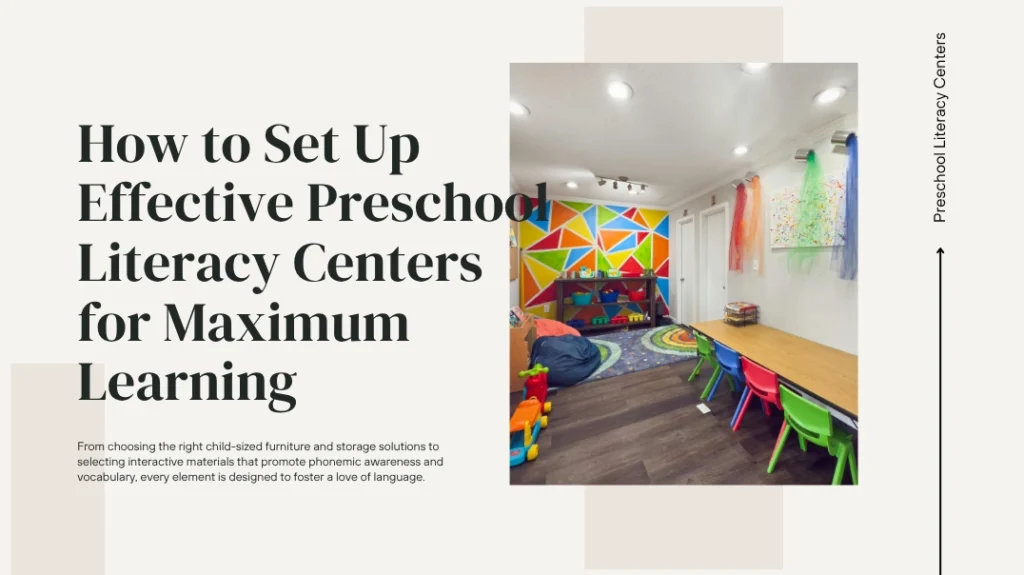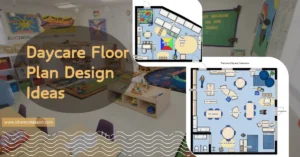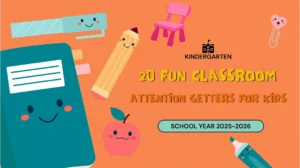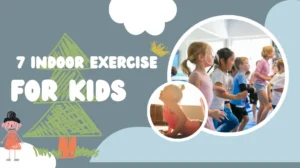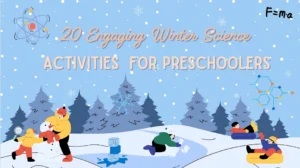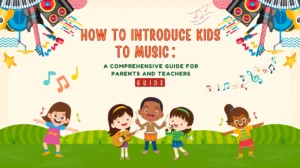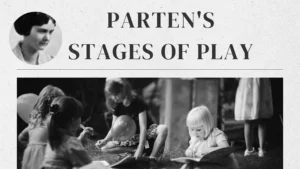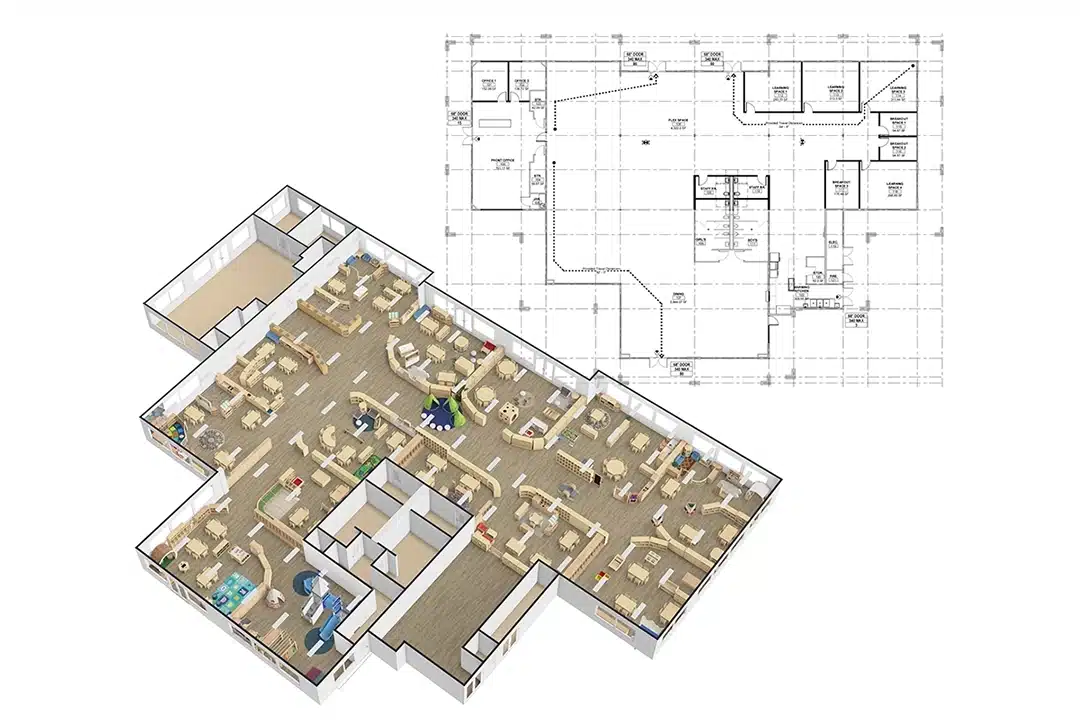Setting up a reading space sounds simple, but most educators and parents feel overwhelmed when it comes to designing meaningful preschool literacy centers. What furniture should you use? How do you organize materials without clutter? Where should the center be located for maximum impact?
Without the proper setup, literacy corners often go unused. Materials become scattered, children lose interest, and opportunities for early reading engagement are missed. A poorly designed center can do more harm than good, frustrating educators and little learners.
But with thoughtful planning and the proper setup, preschool literacy centers can become the most loved and effective learning zones in any early childhood classroom. In this guide, you’ll learn how to design, furnish, and organize a preschool literacy area that sparks curiosity, supports independence, and builds essential early reading skills—step by step.
Introduction
A well-designed Preschool Literacy Center is more than just a corner with books—it’s the heart of language development in early childhood education. It’s where children discover the joy of storytelling, explore letters and sounds, and build vocabulary through independent play and guided learning.
In this article, we’ll walk you through the key steps to setting up powerful preschool literacy centers that are engaging and developmentally appropriate and built to support a wide range of literacy skills. Whether designing a brand-new classroom or improving an existing space, you’ll find practical ideas for choosing the correct location, selecting child-friendly furniture, organizing materials, and fostering a rich, print-based environment.
We’ll also share essential tips on how to make these centers inviting and functional—ensuring every child feels encouraged to read, write, and express themselves. If you aim to build a preschool literacy zone that empowers young readers, supports your curriculum, and gets used—this guide is for you.

Why You Need a Literacy Center
A preschool classroom is full of energy, exploration, and discovery. Amid the noise of building blocks and dramatic play, a dedicated Preschool Literacy Center offers something children need just as much—quiet focus, a love of stories, and early reading skills. That’s why having an intentional literacy center is more than a trend; it’s a foundational piece of quality early childhood education.
A Preschool Literacy Center Gives Reading a Place of Its Own
Young children are naturally drawn to books, letters, and symbols—but only if they can see, reach, and explore them freely. Creating a defined space filled with books, alphabet tools, and writing materials gives early literacy the space and importance it deserves. The physical environment tells children: “This matters.”
A designated preschool literacy center in preschool also supports print-rich environments, one of the most research-supported strategies for fostering early reading and writing. Whether you’re labeling baskets, displaying alphabet charts, or offering name cards, you’re helping children connect spoken language to written words—organically and daily.
Consistency Supports Confidence
Routine and repetition are vital in early learning. When children know where to find a favorite storybook or where to place their journals, they build confidence. The consistency of a well-maintained literacy corner gives them a sense of control over their learning environment. It becomes their go-to space for storytelling, exploring sounds, and pretending to read—without needing adult direction every step.
Preschool Literacy Centers Promote Independence and Choice
Unlike whole-group story time, a literacy center encourages children to make choices. They can pick a book, use letter stamps, or trace a word at their own pace. This autonomy supports preschool literacy growth and important self-regulation and decision-making skills.
The literacy center becomes a self-managed space when equipped with child-height furniture, labeled baskets, and Montessori-style materials. Children naturally return to it when they feel curious or inspired, which increases both time spent with literacy and depth of engagement.
It’s the Foundation for Later Literacy Success
Children who engage daily with print, letters, and books in preschool are likelier to become confident readers in elementary school. Preschool literacy centers lay that groundwork. They give children early access to the building blocks of reading: alphabet awareness, vocabulary, phonemic recognition, and a love of language.
How to Choose the Right Location for Your Preschool Literacy Center
The physical placement of your Preschool Literacy Center is one of the most important—but often overlooked—parts of classroom design. A well-chosen spot can turn a simple corner into a dynamic, self-guided literacy hub. A poor location, on the other hand, can make even the best materials go unused.
Look for a Quiet, Low-Traffic Area
A literacy center should feel calm and inviting. Avoid placing it near high-energy zones like the dramatic play area or block station. Instead, choose a spot near a wall, under a window, or in a nook where children naturally slow down. This helps signal that the preschool literacy center is a space for quiet thinking, reading, and exploring letters.
Many teachers successfully create literacy corners along the back of the classroom or in semi-separated alcoves. Bookshelves, reading rugs, or light furniture dividers can subtly define the space without closing it off.
Prioritize Accessibility and Visibility
Children need to see the preschool literacy center to use it. If it’s hidden behind a cabinet or squeezed between noisy stations, they’re less likely to engage. Make sure the space is visible from most areas of the room so it feels like an integrated part of the environment—not an afterthought.
Use open shelving, low baskets, and front-facing book displays to keep materials at eye level. If students have to ask an adult to access something, it no longer feels like their space.
Think Light, Sound, and Movement
Natural light boosts attention and interest, so if possible, place your center near a window. Use soft lighting (like a clip-on lamp or reading light) to make the space feel cozy and warm, especially if the rest of the room uses bright fluorescent bulbs.
Adding a reading rug, small fabric canopy, or sound-softening materials can make the space more focused and comforting if your classroom is echoey or busy.
Adapt Based on Classroom Shape and Age Group
Not every room will allow for a dedicated 5 × 7 ft literacy nook—and that’s okay. What matters most is that the space is thoughtfully placed, visually distinct, and scaled to your learners.
- For younger preschoolers (ages 3–4), choose a smaller area with soft seating and tactile alphabet materials.
- For older preschoolers (ages 4–5), offer a more extended shelf for books, simple word wall materials, and a mini writing station.
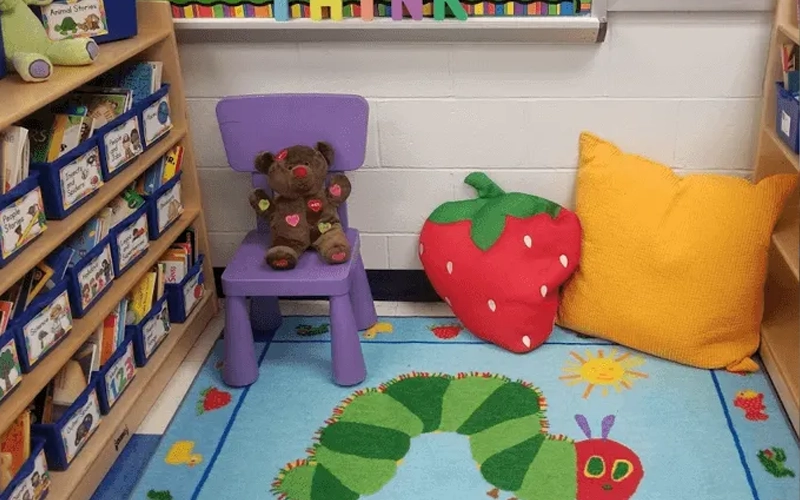
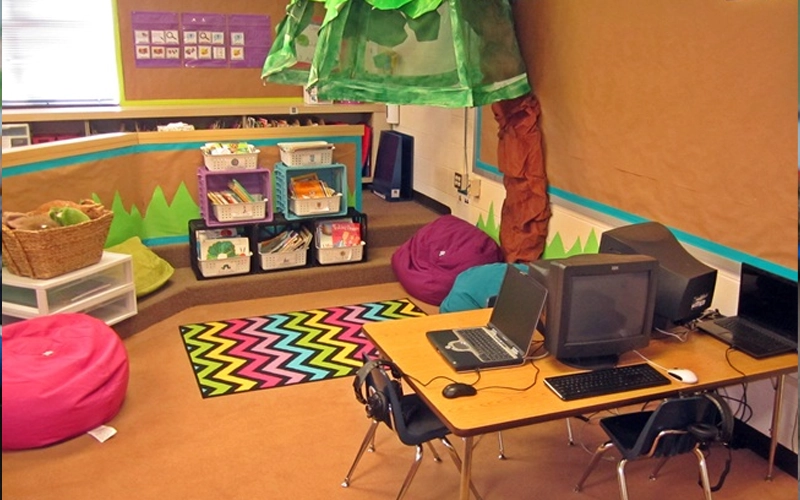
Furniture Selection Guide for Preschool Literacy Centers
Designing an effective Preschool Literacy Center goes far beyond adding a bookshelf and a few pillows. The furniture, layout, and learning materials play a significant role in creating a space that encourages young children to read, write, and explore language independently.
Here’s how to set up an inviting and developmentally appropriate literacy space.
Reading Seating: What Works Best and Why
Comfort is key when getting preschoolers to spend time with books. If a child isn’t physically comfortable, they won’t stay long enough to engage truly. Here are your best options:
- Soft chairs Provide gentle support and create a “special spot” that feels inviting. They are ideal for corners or near bookshelves.
- Bean bags: Flexible, easy to move, and naturally low to the ground. Children love sinking into them while reading.
- Floor cushions or mats are perfect for shared reading or large group browsing. Offer multiple textures or colors to add interest.
Each promotes relaxed posture, ownership, and extended reading time. Make sure all seating is child-sized, washable, and easy to rearrange.
Display Furniture: Make Books the Centerpiece
The best way to invite children into preschool literacy is to showcase books visibly and beautifully. Instead of spine-out shelving, use:
- Front-facing bookshelves: These display books covers clearly and act like visual invitations to explore.
- Display ledges or slanted shelves: Great for rotating thematic books, featured authors, or seasonal topics.
- Mobile book racks: Offer flexibility and can be wheeled into circle time or quiet corners.
Position these displays at eye-level and keep selections curated (not overcrowded) to avoid visual overwhelm. Rotating books weekly keeps the display fresh and encourages return visits.
Environment Enhancers: Set the Mood for Preschool Literacy
Physical comfort and aesthetic warmth matter. A few environmental elements can transform your literacy space from “just a corner” to a literacy destination:
- Reading rugs: Define the space visually and soften floor seating. Choose colors or themes that tie into classroom decor.
- Corner dividers: Use bookshelves or lightweight screens to visually separate the space without closing it off.
- Soft lighting: Clip-on reading lamps, light strings, or natural light enhance coziness and reduce glare.
- Child-sized furniture: All materials and surfaces should be within reach, without adult assistance.
These touches promote longer stays, better focus, and a sense of calm that supports sustained reading and writing exploration.
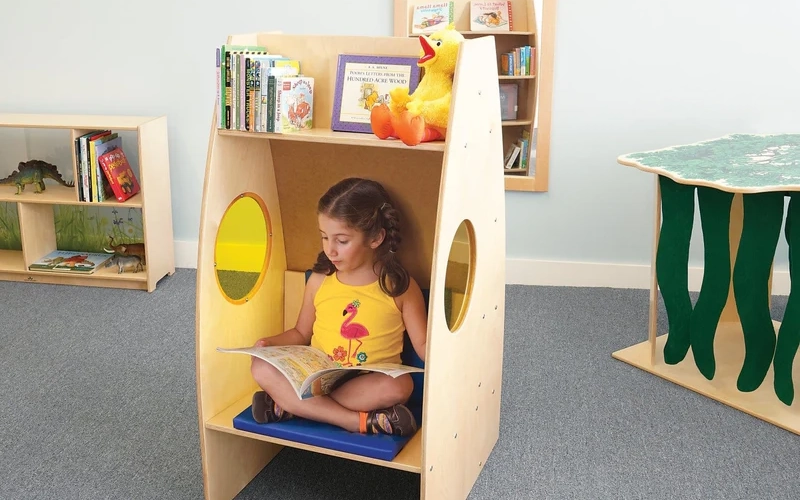
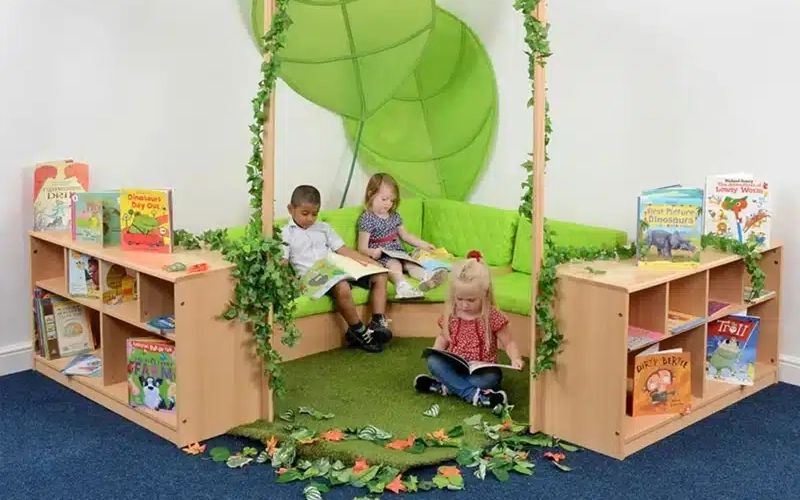
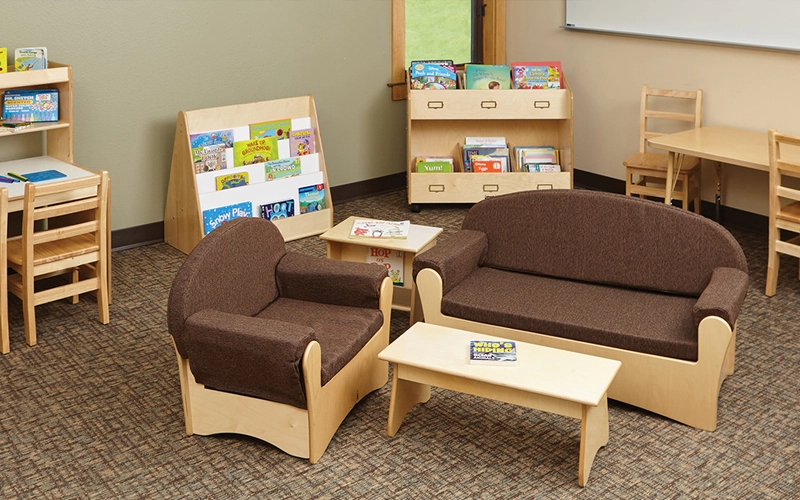
Quick Reference: Furniture Essentials for Your Preschool Literacy Center
| Purpose | Furniture/Item |
|---|---|
| Reading Comfort | Soft chairs, bean bags, floor mats |
| Material Storage | Open shelves, labeled baskets, book bins |
| Display | Front-facing bookshelf, mobile racks |
| Environment | Reading rug, clip-on lamp, corner divider |
| Accessibility | Child-sized table and chairs, writing surface |
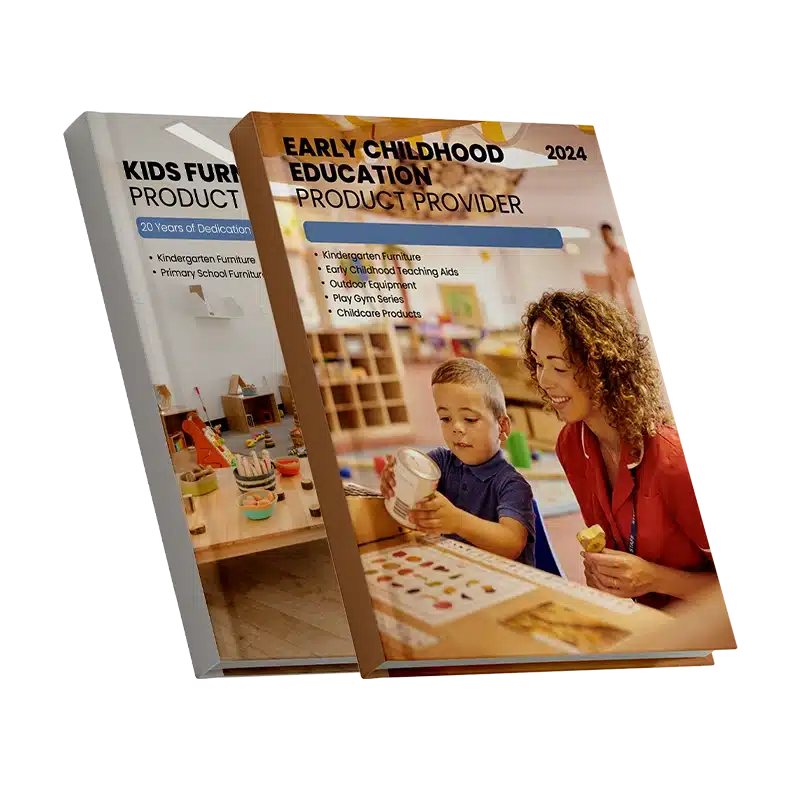
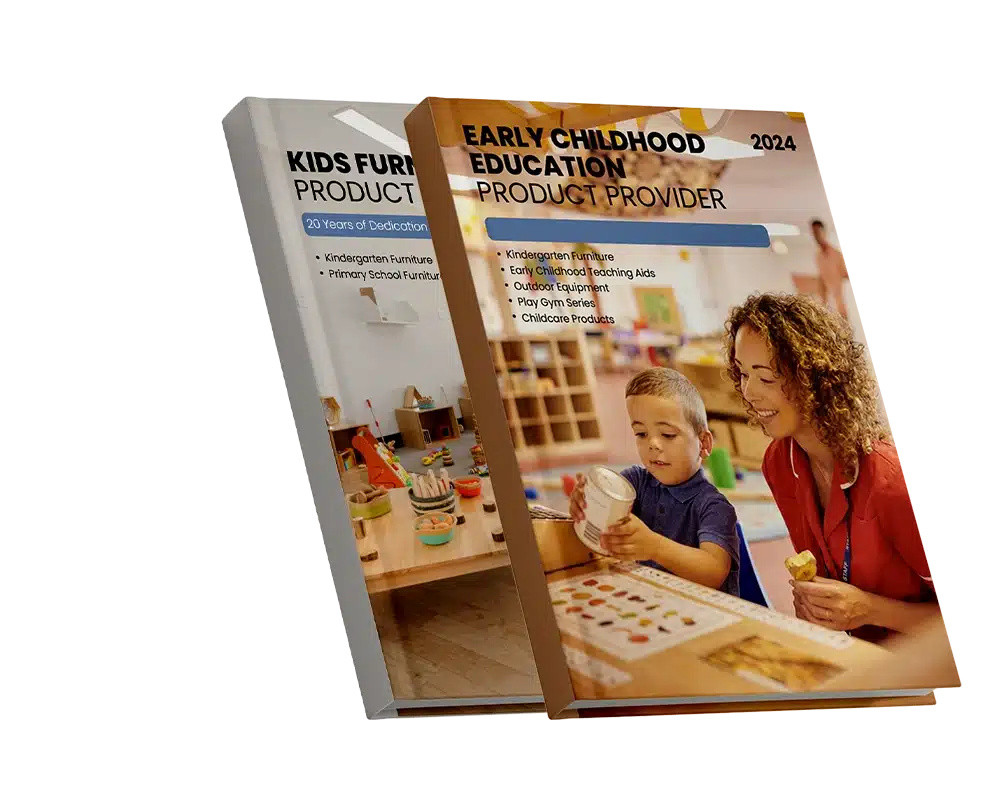
Furniture Layout Tips: Creating a Functional Literacy Area
An ideal preschool literacy center should be open for free movement but structured enough to guide focus. The arrangement of preschool furniture should support exploration, social interaction, and quiet reading time.
Here are some best practices for literacy center setup:
- Define the space: Use low bookshelves, floor rugs, or child-sized seating to create a clear boundary. This helps signal the purpose of the literacy area without fully enclosing it.
- Zone for quiet learning: Place the center away from high-energy zones like blocks or dramatic play. A calm corner allows children to concentrate on reading or writing.
- Flow matters: Arrange the classroom furniture so children can transition from browsing books to sitting comfortably. Writing tools should be near a flat surface like a child-sized table or preschool literacy desk.
- Flexible use: Incorporate moveable furniture for solo, pair, and group reading options. For example, cube stools or bean bags can be repositioned for literacy small group activities.
Common Mistakes to Avoid When Setting Up Preschool Literacy Spaces
Even well-intended classrooms sometimes fall into furniture pitfalls that affect literacy engagement.
Here’s what to watch out for:
- Oversized furniture: Avoid adult-sized chairs or tables. They are uncomfortable and discourage independent use. Stick to developmentally appropriate preschool furniture designed for small bodies.
- Closed storage systems: Bins with lids or high shelves keep materials out of sight. Use open storage that makes preschool literacy materials visible and accessible.
- Too much clutter: Too many books, tools, or posters can distract young learners. Rotate literacy materials in preschool classrooms regularly and keep displays simple.
- Inconsistent design: Bright colors everywhere may feel fun, but too many competing tones overwhelm children. Stick to a calming color palette and use pops of color for highlights.
Modular & Mobile Furniture Solutions for Flexible Classrooms
Classrooms are constantly evolving. Preschool literacy centers that adapt to change are more effective in the long term. Using modular and mobile furniture allows educators to rearrange spaces without disrupting routines.
Try these ideas:
- Mobile book racks: Rolling shelves let you rotate books based on seasons, holidays, or units (great for themes like fall literacy activities for preschoolers).
- Foldable tables: Use collapsible writing tables to convert a space from preschool literacy to STEM or art.
- Reversible display shelves: One side can show books, while the other holds writing and literacy activities for preschoolers.
- Multi-use storage: Consider a reading bench with built-in cubbies for storing preschool literacy games or flashcards.
These options support flexible setups for both everyday routines and seasonal curriculum changes.
Visual Guide: Literacy Center Setup Examples
Having a clear visual structure can make a big difference when designing your preschool literacy centers. A well-organized setup promotes smoother transitions and enhances engagement by drawing children’s attention toward language-rich opportunities.
Here are a few compelling literacy area layout examples:
- U-Shaped Reading Nook
- Use low bookshelves to create a U-shaped nook around a cozy rug. This semi-enclosed shape fosters focus while allowing easy adult supervision. Place picture books and wordless stories on open racks at child level to invite independent exploration.
- Split-Zone Setup for Multi-Use
- Divide the preschool literacy area into two parts: one for listening or reading with soft seating (pillows, small chairs), and the other for writing practice with a small table, alphabet stamps, or magnetic boards. Use floor mats to differentiate zones subtly.
- Wall-Mounted Word Center
- Mount a chalkboard, felt board, or dry-erase panel to display letter of the week, sight words, or theme-based vocabulary. Surround it with baskets of supporting books, puppets, and printable preschool literacy activities for preschoolers.
- Themed Rotation Corners
- Use a mobile literacy shelf and anchor visuals to create rotating seasonal or topic-based mini-centers (e.g., “Ocean Literacy Area,” “Fall Book Spot,” “Bug Word Wall”). This approach helps incorporate targeted language and literacy in preschool themes while reusing furniture creatively.
These layouts support differentiated learning and offer practical preschool literacy center ideas teachers can apply across changing classroom needs.
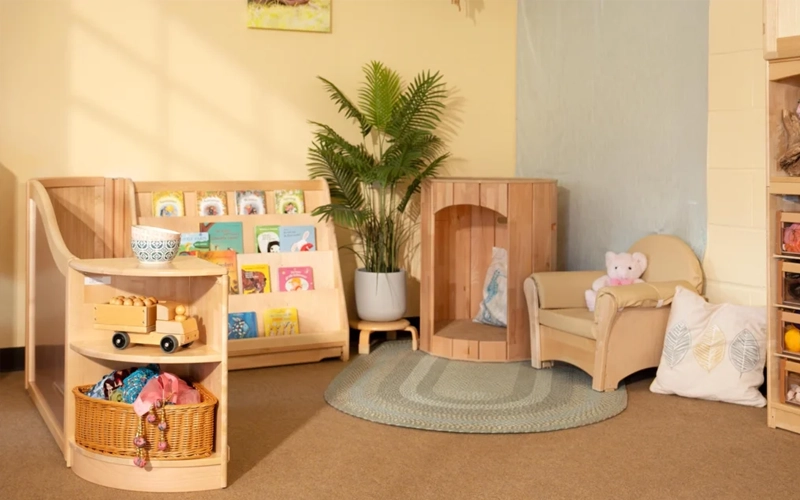
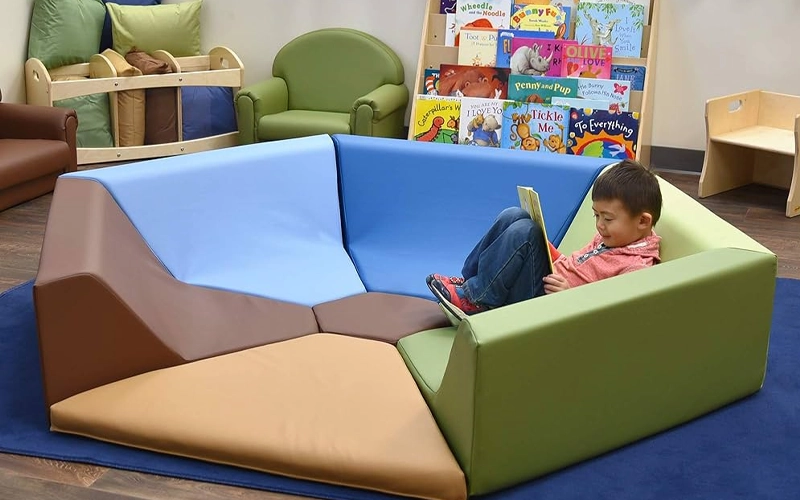
Expanded Literacy Materials Checklist for Preschool Literacy Centers
An effective Preschool Literacy Center is more than a cozy corner with books—it’s a rich language environment built on intentional materials that support early literacy development. Teachers must thoughtfully select, organize, and rotate materials that align with age, skill level, and learning goals to deepen learning and exploration.
Below is an expanded guide to the most essential categories of preschool literacy materials, along with practical examples, usage strategies, and optimization tips for classroom success.
Books: Building a Foundation for Reading Enjoyment and Comprehension
Books are the heart of any preschool literacy area. But simply providing “some books” isn’t enough. A diverse, well-curated collection encourages reading habits and fosters comprehension through exposure to language, structure, and storytelling.
Recommended types of books for Preschool Literacy Centers:
- Board Books & Cloth Books: Durable options for toddlers and younger preschoolers.
- Picture Books: Include classic and contemporary titles with rich illustrations.
- Multicultural & Bilingual Books: Reflect diverse backgrounds, families, and languages.
- Rhyming Books: Promote phonological awareness and rhythm of language.
- Interactive Books: Touch-and-feel, lift-the-flap, or sound books help engage reluctant readers.
Keep books front-facing on display racks for visibility. Include 15–20 books in bins, and rotate every 2 weeks to maintain engagement.
Alphabet Resources: Hands-on Tools for Letter Recognition and Phonemic Awareness
Children learn letters through tactile interaction, visual identification, and auditory reinforcement. Alphabet manipulatives allow preschoolers to explore letters playfully and independently.
Adequate alphabet resources include:
- Magnetic Letters & Trays: For spelling simple words or name recognition.
- Letter Puzzles: Match shapes and sounds.
- Sandpaper Letters: Promote fine motor control and letter formation via tactile memory.
- Alphabet Sorting Cards: Pair pictures with beginning sounds or upper-lowercase matches.
- Plastic or Felt Letters: Can be sorted by color, case, or phoneme group.
Integrate letter-of-the-week activities using rotating sets of these materials.
Writing Tools: Encouraging Emergent Writing and Storytelling
In preschool, writing is messy, symbolic, and expressive. The goal isn’t legibility—it’s confidence and intent. Giving children access to appropriate writing tools allows them to experiment with mark-making and storytelling.
Must-have writing materials for preschool:
- Mini Chalkboards & Dry-Erase Boards: Reusable and great for name tracing.
- Crayon Packs & Pencils: Fat, easy-grip options for developing fine motor skills.
- Pre-Writing Worksheets: Trace lines, curves, and simple letters.
- Blank Journals or Drawing Books: Encourage open-ended creativity.
- Name Cards & Letter Stencils: Scaffold letter formation and spelling.
Place tools in labeled caddies. Rotate writing sheets to match literacy themes (e.g., animals, weather, holidays).
Visual Supports: Embedding Print into the Environment
Preschoolers are natural observers. Embedding print-rich visuals into your literacy center helps them make meaningful connections between spoken and written language.
Effective visual materials include:
- Word Walls: Display seasonal or high-frequency words with visuals.
- Alphabet Posters & Strips: Reinforce order and letter-sound correspondence.
- Labelled Classroom Objects: E.g., “chair,” “door,” “paint,” using both images and words.
- Interactive Charts: Letter of the day, word families, or rhyming sets.
Laminate posters and cards to keep them clean and durable. Use Velcro or magnets for easy rotation.
Montessori-Inspired Materials: Language Through Sensory and Matching
Montessori classrooms focus on sensory learning and independent discovery, which align well with literacy development. Even in non-Montessori classrooms, teachers can borrow Montessori principles through hands-on and self-correcting materials.
Suggested Montessori literacy items:
- Sandpaper Letters & Tracing Boards: Encourage muscle memory and phonics blending.
- Object-to-Card Matching Trays: Match miniatures (e.g., cat, fan, net) with beginning sounds or word cards.
- Phonetic Boxes: Group objects by starting phonemes or vowels.
- Sound Cylinders or Rhyming Baskets: For auditory discrimination.
Display Montessori materials on low, open shelving. Present them on trays or mats to teach order and routine.
Adapt the ‘See‑Show‑Say’ Strategy
One effective strategy for promoting preschool literacy is the “see‑show‑say” approach. Show an object or letter (e.g., a picture or a flashcard), say the name or sound aloud, and encourage the child to repeat it. For example, hold up a card labeled “dog,” say “dog,” emphasize the initial /d/ sound, and invite the child to echo. This strengthens connections between visuals, vocabulary, and phonemic awareness.
Encourage Play‑Based Learning
Play is a powerful avenue for literacy. Let children use letter puppets, story blocks, or picture props to explore language in pretend-play scenarios. For example, a small puppet theater corner beside the reading rug playfully invites storytelling.
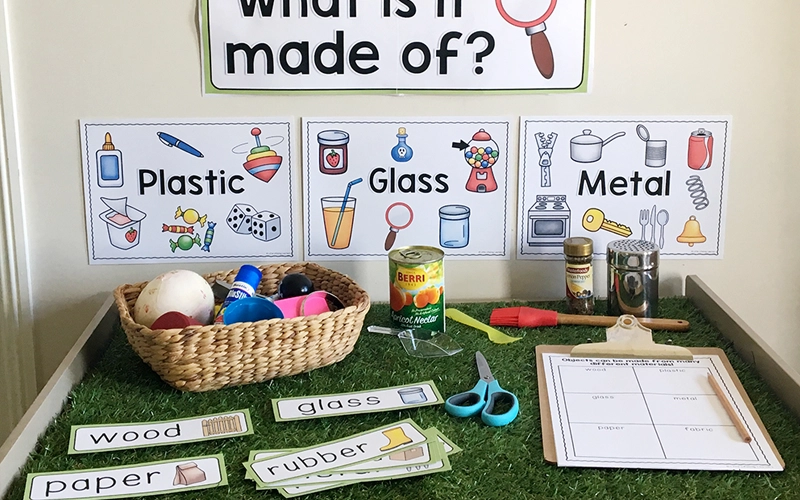
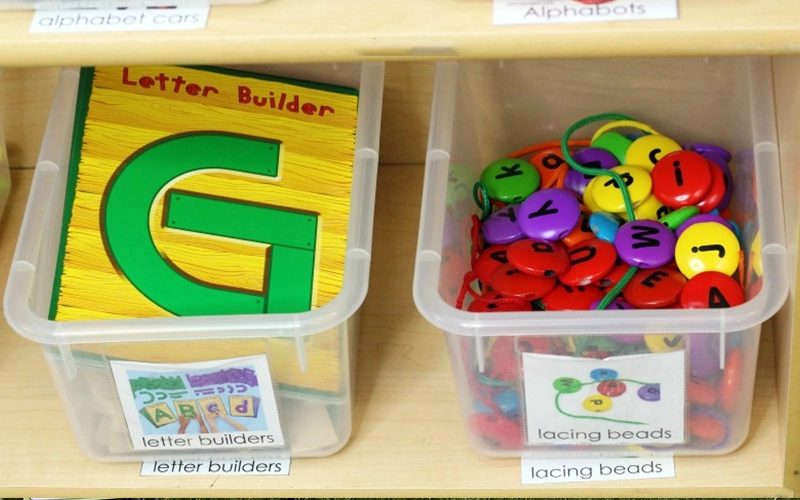
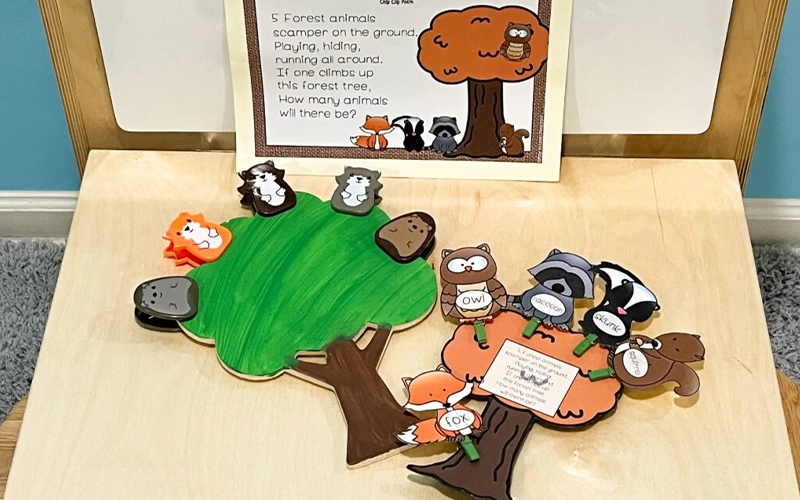
How to Organize Materials in Preschool Literacy Centers
Organizing materials effectively in your Preschool Literacy Center is the step where design meets function. Innovative organization ensures children can independently access, use, and return items while maintaining a tidy, inviting space. Here’s a detailed guide:
1. Sort by Skill, Type, or Theme
Arrange materials in bins, trays, or book bins based on what children are ready to explore:
- By skill level: Separate alphabet games, tracing sheets, and simple sight word tools.
- By content type: Group alphabet manipulatives, writing tools, picture books together.
- By theme: Organize seasonal or topical materials—like fall books, animal word cards, or holiday-themed storybooks.
Label each bin with a word and a picture—such as “Animal Books” or “Fall Tracing Sheets”—to support early readers and visual learners.
2. Use Labeled Containers, Rotating Baskets, and Thematic Trays
Clear containers help maintain order and guide exploration:
- Picture-labeled baskets: Keep letter puzzles, sandpaper letters, or journal caddies in separate bins.
- Rotating baskets: Swap out materials weekly—like a “letter of the week” bin featuring magnetic letters or alphabet stamps.
- Thematic trays: Use decorative trays to display holiday poems, rhyming packets, or multicultural books around a theme.
Maintain only 3–5 materials per tray to avoid visual overload and support deeper engagement with each item.
3. Encourage Independence with Reachable, Visually-Guided Storage
Encourage self-directed learning by making everything accessible:
- Low open shelves: Place frequently used books and manipulatives at child height.
- Clear plastic bins with front openings: Let kids see and retrieve materials without adult help.
- Visual guides: Add quick image examples on each container, such as “Put all alphabet puzzles here” with a small photo below the title.
Watch the retrieval process—if a child struggles, consider repositioning that item to a more accessible location or adding clearer visuals.
4. Maintain Visual Order Without Overload
Striking the right visual balance is key:
- Limit colors: Use neutral baskets with colorful accents on labels, instead of brightly colored bins everywhere.
- Keep shelf categories clean: A tidy, well-organized space encourages calm and focus.
- Rotate visually-challenging items: Introduce new patterns or materials slowly so the space remains inviting, not overwhelming.
Repeat the same container styles for different categories, creating consistency and reducing classroom clutter.
Why This Matters
Organizing materials isn’t just tidying—it supports key early literacy development:
- Print awareness: When children see labels, words, and images consistently, they make subconscious connections between spoken names and written text.
- Skill progression: Arranging materials by difficulty enables children to choose what matches their current learning stage.
- Thematic engagement: Rotating literacy bins by theme (e.g., “space words,” “ocean letters”) helps sustain interest and contextual learning.
Quick Visual Organizer Template
| Category | Container Type | Example Label |
|---|---|---|
| Alphabet Games | Small tray + label | “ABC Puzzles” |
| Magnetic Letters | Clear bin with picture | “Magnetic Letters” |
| Writing Tools | Caddy with compartments | “Crayons & Journals” |
| Themed Books | Display basket | “Fall Storybooks” |
| Tracing Sheets | Letter folder tray | “Pre-Writing Lines” |
This structured yet flexible system allows your Preschool Literacy Center to stay clutter-free, accessible, and engaging. As you implement this setup, you’ll see children gravitate toward materials confidently, choose what interests them, and cultivate literacy habits rooted in independence and curiosity.
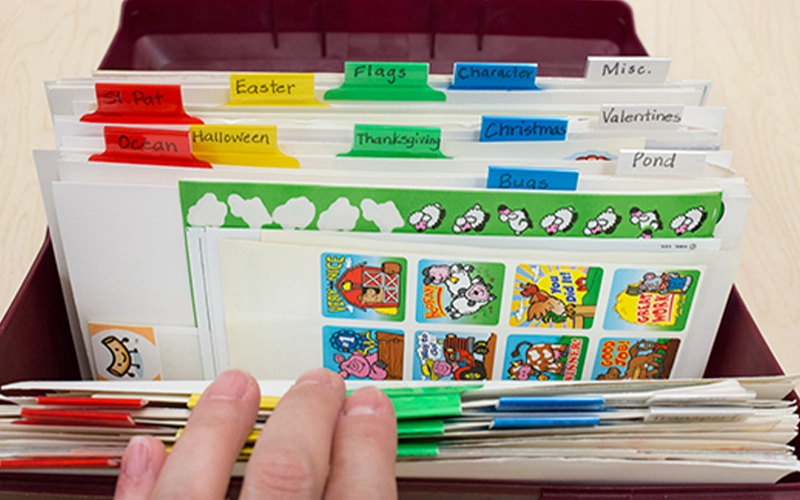
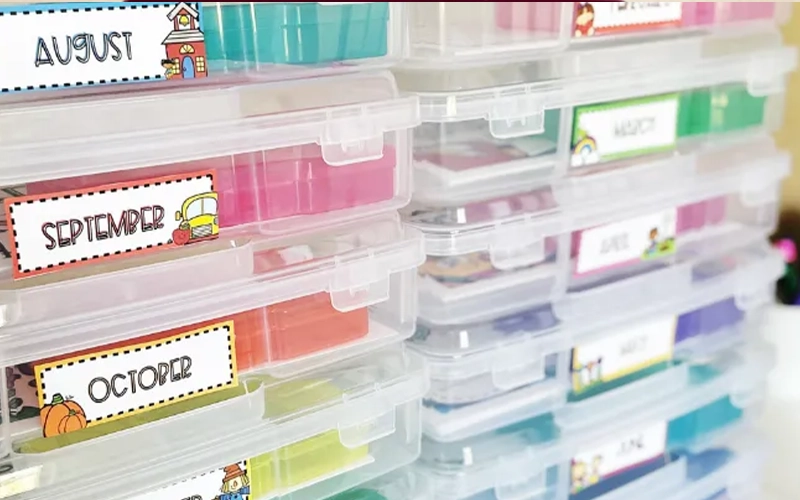
Designing a Child‑Friendly Environment in Preschool Literacy Centers
Creating a cozy, welcoming atmosphere in your Preschool Literacy Center is about more than furniture—it sparks joy, curiosity, and a sense of ownership. This section focuses on visual, tactile, and emotional design, giving children a warm and playful space.
1. Embrace Environmental Print to Build Literacy Awareness
- Label everyday items – picture-plus-word tags on baskets, table bins, and cozy chairs help children associate print with meaning.
- Name tags and personalized materials: Include each child’s name on a cubby or reading pouch. This promotes identity and print familiarity.
- Letter posters and alphabet art—decorative yet educational wall pieces that enhance letter recognition in a soft way instead of rigid flashcards.
These small visual cues reinforce a print‑rich environment without feeling overly academic.
2. Use Front‑Facing Displays at Eye Level
- Position storytelling and picture books facing outward on low shelves so children can see covers and choose at a glance.
- Rotate visually engaging themes—seasonal, multicultural, or holiday picks—to draw attention and keep the space fresh.
- Add a sign like “New Books!” to highlight the feature shelf and invite children to explore.
These tactics boost book interest while supporting visual literacy habits in a friendly setting.
3. Create a Cozy Vibe with Warm Textures and Soft Lighting
- Rugs and floor cushions signal a soft, lounge-like reading zone—layered textures and calm colors.
- Fabric canopies or tent-like book nooks add a hidden, imaginative spot children love to retreat into.
- Soften the overhead lighting or use fabric lamp shades to reduce glare and create a relaxed mood.
Together, these elements foster a sense of calm, encouraging children to linger and enjoy literacy materials.
4. Maintain Visual Calm Through Consistent Style
- Choose a coordinated color palette, such as neutrals with gentle accent shades like sage, mustard, or terra cotta.
- Use natural materials—wood shelves, wicker baskets, fabric bins—to avoid a plastic-heavy environment.
- Rotate or remove busy visuals to prevent sensory overload. Keep only a few focal pieces to maintain a calm backdrop.
This design focus helps children feel grounded and mentally prepared for focused literacy engagement.
5. Model a Love for Reading and Writing
Children are keen observers who learn more from what adults do than from what they hear. When caregivers consistently demonstrate genuine enjoyment of literacy—reading books, writing simple notes, even reading recipes—it sends a clear message: literacy is meaningful and enjoyable. Include a display like “Staff Picks” on a small shelf or invite children to see what you’re reading today.
6. Infuse Playful Details That Delight and Engage
- Include a small literacy-themed plush toy or puppet related to stories—like a storytelling fox or reading bear.
- Hang soft fabric pennants or a gentle letter-theme birthday banner to celebrate monthly literacy milestones.
- Integrate a small mirror or word art in the literacy corner so children can explore writing or letters playfully.
These whimsical touches deepen emotional connection without shifting focus from reading and writing tools.
7. Support Multiple Learning Styles
Design your literacy corner to cater to visual learners (picture charts, color-coded materials), auditory learners (word wall with rhymes, listening pov), kinesthetic learners (sensory tracing trays, moveable cushions), and logical learners (alphabet puzzles and word sorting trays). This inclusivity enriches engagement and supports developmental diversity.
The Missing Piece in Your Literacy Center
While well-planned furniture and materials form the structure of a Preschool Literacy Center, the child-friendly atmosphere makes it an inviting home for early literacy discovery. Learning becomes effortless and joyful when children feel relaxed, valued, and emotionally connected to their space.
Conclusion
Designing and setting up effective preschool literacy centers is more than arranging furniture or placing books on shelves—it’s about creating a dynamic, inclusive, and inspiring space that nurtures early literacy development. By carefully selecting child-friendly materials, organizing resources for independent access, and curating an environment that supports diverse learning styles, you’re laying the foundation for lifelong reading and communication skills.
Whether through interactive word walls, sensory writing stations, or modular furniture for small group activities, every decision you make shapes how young children connect with language. With thoughtful planning and intentional design, your literacy centers can become the heart of your classroom—where curiosity, language, and imagination thrive daily.
FAQs
1. What materials should be included in a preschool literacy center?
Include age-appropriate books, writing tools, alphabet manipulatives, and themed vocabulary cards. Store items in child-accessible containers to encourage independent use.
2. How can I keep the literacy center organized and engaging?
Rotate materials regularly based on themes or seasons, use clear labels with pictures, and include quiet and interactive options to suit different learning styles.
3. What are common mistakes to avoid when setting up a literacy center?
Avoid overcrowding, using adult-sized furniture, or placing the center near noisy classroom areas. Also, don’t lock materials away—make literacy tools visible and inviting.
4. How much space do I need for a literacy center?
A literacy center doesn’t need to be large. Even a small, well-defined nook with child-sized furniture and rich language resources can be highly effective if well organized.
5. What are the five literacy skills?
There are five essential literacy skills: phonological awareness, phonics, fluency, vocabulary, and comprehension. These skills are interrelated and work together to improve reading ability.
6. Do screen-based apps help or hurt preschool literacy development?
Educational apps can support literacy if chosen carefully. Look for interactive, language-rich apps that encourage participation, and always co-view with your child to make it a shared learning experience rather than passive screen time.
7. What are some signs my child may need extra help with literacy?
Red flags include difficulty recognizing letters after age 4, limited interest in books or stories, trouble following simple instructions, or challenges with basic vocabulary. If concerned, consult a pediatrician or early childhood educator.
8. What’s the difference between phonics and phonemic awareness?
Phonemic awareness is the ability to hear and manipulate sounds in words (e.g., rhyming, segmenting), while phonics connects those sounds to written letters. Both are essential, but phonemic awareness usually develops first.

